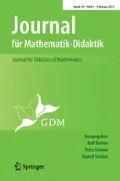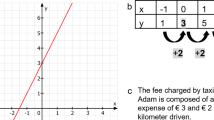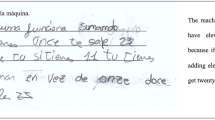Abstract
Functional relationships are fundamental for mathematics education in every grade. They are also relevant for other subjects such as politics and form part of our everyday life. Students are confronted with functional relationships consciously and unconsciously, and thereby develop functional thinking (FT) even in early grades. Functional thinking is commonly described by the aspects mapping, covariation, and function as object. Nevertheless, whether these aspects can be seen as separate dimensions of FT or whether FT should be treated as a one-dimensional construct has not yet been verified empirically. Therefore, this study was concerned with constructing and validating a test to measure FT that offers insight into its psychometric structure in its beginnings. We first operationalized FT according to the three abovenamed aspects, using the different forms of representation in which functional relationships occur (table, graph, verbal description). The appropriate use of and change between these forms was considered an indication of FT. After developing items to test FT, their fit to the operationalization was controlled (expert rating: N = 2, κ = 0.86). Thereafter, a test was created and implemented among students at the age of 12 to 13 which is grade 7 in Germany (N = 221). Using item response theory, we controlled for Rasch scalability. Our test showed a plausible values based expected a posteriori (EAP/PV) reliability of EAP/PV = 0.77. Next, we estimated a one-dimensional, a three-dimensional between, and a three-dimensional within model to describe FT and compared the models’ fit to our data using information criteria. The results of the model comparison indicate that psychometrically, FT should be seen as a one-dimensional construct.
Zusammenfassung
Funktionale Zusammenhänge sind grundlegend für den Mathematikunterricht in jeder Jahrgangsstufe; sie sind auch relevant für andere Unterrichtsfächer wie Politik, und sie sind Teil unseres Alltags. Schülerinnen und Schüler werden mit ihnen bewusst und unbewusst konfrontiert und entwickeln dabei bereits in den unteren Jahrgangstufen funktionales Denken (FD). Beschrieben wird FD in der Regel mittels der 3 Aspekte Zuordnung, Änderungsverhalten und Funktion als Objekt. Empirisch wurde bisher nicht untersucht, ob diese Aspekte als unterschiedliche Dimensionen des FD angesehen werden sollten oder ob FD psychometrisch als eindimensionales Konstrukt zu betrachten ist. Daher befasste sich diese Studie mit der Entwicklung und Validierung eines Tests zur Messung des FD in seinen Anfängen, der es ermöglichen sollte, Einblick in die psychometrische Struktur des FD zu erlangen. Zunächst wurde FD hinsichtlich der 3 benannten Aspekte operationalisiert, wobei angenommen wurde, dass sich FD im angemessenen Umgang mit und im Wechsel zwischen verschiedenen Repräsentationsformen funktionaler Zusammenhänge (Tabelle, Graph, situative Beschreibung) zeigt. Nach der Itementwicklung wurde die Passung von Items und Operationalisierung mittels Expertenrating überprüft (N = 2; κ = 0,86). Der darauf aufbauend konstruierte Test wurde von 221 Schülerinnen und Schülern aus Jahrgangsstufe 7 im Alter von 12 bis 13 bearbeitet. Unter Verwendung der Item-Response-Theorie wurde der Test auf seine Rasch-Skalierbarkeit hin überprüft, er erreichte eine auf „plausible values basierende expected a posteriori“ (EAP/PV) Reliabilität von EAP/PV = 0,77. Anschließend wurden ein eindimensionales Modell, ein dreidimensionales Between-Modell sowie ein dreidimensionales Within-Modell zur Beschreibung des FD bewertet. Die Passung der Modelle zu den Daten wurde mittels Informationskriterien überprüft. Die Ergebnisse des Modellvergleichs deuten darauf hin, dass FD psychometrisch als eindimensionales Konstrukt betrachtet werden sollte.



Similar content being viewed by others
Notes
In many federal states of Germany there are three types of school. We distinguish between Gymnasium, Realschule, and Hauptschule. Hauptschule is a special type of secondary school, offering a general education to students not accepted for Gymnasium or Realschule.
All items that were used to test FT are provided in Online Resources 1 (English) and 2 (German). We will refer to single items during this article by name and number.
Compare, e. g., the last PISA results (2015), which revealed a considerable difference in mathematical competencies of boys and girls in Germany (Reiss et al. 2016). Therefore, gender-DIF can be expected and needs to be checked to sort out items that lead to a big difference between the two groups. If there are items found that lead to gender-DIF, we need to analyze what causes DIF in a next step.
This analysis was performed using a one- and a three-dimensional Rasch model. All items that negatively influence one of these models were excluded according to the presented criteria. Due to space limitations and the results, we only present the analysis of the one-dimensional model here.
Handling DIF items is not easy. Cho et al. (2016), e. g., describe five practices for dealing with DIF items based on a review of 27 articles of the American Psychology Association Journals: delete (30%), no further action mentioned (33%), use DIF items instead of (26%), multi-group analysis (7%), and model DIF (4%).
References
Adams, R. J., & Wu, M. (Eds.). (2002). Pisa 2000: Technical report. Paris: OECD.
Barzel, B., Hußmann, S., & Leuders, T. (2005). Der „Funktionenführerschein“: Wie Schüler und Schülerinnen das Denken in Funktionen variantenreich wiederholen und festigen können. Praxis der Mathematik, 47(2), 20–25.
Baumert, J., Lehmann, R., Lehrke, M., Clausen, M., Hosenfeld, I., Neubrand, J., Patjens, S., Jungclaus, H., & Günther, W. (Eds.). (1998). Materialien aus der Bildungsforschung: Nr. 60. Testaufgaben Mathematik TIMSS 7./ 8. Klasse. Berlin: Max-Planck-Institut für Bildungsforschung.
Blanton, M. L., & Kaput, J. J. (2005). Characterizing a classroom practice that promotes algebraic reasoning. Journal for Research in Mathematics Education, 36(5), 412–446.
Blanton, M. L., & Kaput, J. J. (2011). Functional thinking as a route into algebra in the elementary grades. In J. Cai & E. Knuth (Eds.), Early Algebraization. Advances in Mathematics education (pp. 5–23). Heidelberg: Springer.
Blanton, M., Schifter, D., Inge, V., Lofgren, P., Willis, C., Davis, F., & Confrey, J. (2007). Early algebra. In V. J. Katz (Ed.), Algebra. Gateway to a technological future (pp. 7–14). Washington, DC: Mathematical Association of America.
Bond, T. G., & Fox, C. M. (2015). Applying the Rasch model: Fundamental measurement in the human sciences (3rd edn.). New York, London: Routledge.
Breidenbach, D., Dubinsky, E., Hawks, J., & Nichols, D. (1992). Development of the process conception of function. Educational Studies in Mathematics, 23(3), 247–285.
Burnham, K. P., & Anderson, D. R. (2004). Multimodel inference: Understanding AIC and BIC in model selection. Sociological Methods & Research, 33(2), 261–304.
Cho, S.-J., Suh, Y., & Lee, W.-Y. (2016). After differential item functioning is detected. Applied Psychological Measurement, 40(8), 573–591.
Cronbach, L. J. (1951). Coefficient alpha and the internal structure of tests. Psychometrika, 16(3), 297–334.
DeMarois, P., & Tall, D. (1999). Function: Organizing principle or cognitive root? In O. Zaslavsky (Ed.), Proceedings of the 23rd Conference of the international Group for the Psychology of Mathematics Education. 23rd Conference of the international Group for the Psychology of Mathematics Education, Haifa Israel. (pp. 257–264).
Doorman, M., Drijvers, P., Gravemeijer, K., Boon, P., & Reed, H. (2012). Tool use and the development of the function concept: From repeated calculations to functional thinking. International Journal of Science and Mathematics Education, 10(6), 1243–1267.
Dubinsky, E., & Harel, G. (1992). The nature of the process conception of function. In G. Harel & E. Dubinsky (Eds.), The concept of function: Aspects of epistemology and pedagogy (pp. 85–106). Washington, DC: Mathematical Association of America.
Ganter, S. (2013). Experimentieren – ein Weg zum funktionalen Denken: Empirische Untersuchung zur Wirkung von Schülerexperimenten. Hamburg: Kovač.
Greefrath, G., Oldenburg, R., Siller, H.-S., Ulm, V., & Weigand, H.-G. (2016). Didaktik der Analysis: Aspekte und Grundvorstellungen zentraler Begriffe. Heidelberg: Springer Spektrum.
Hartig, J., Frey, A., & Jude, N. (2012). Validität. In H. Moosbrugger & A. Kelava (Eds.), Testtheorie und Fragebogenkonstruktion. Springer-Lehrbuch. Berlin, Heidelberg: Springer.
Hartig, J., Kühnbach, O., & Ittel, A. (Eds.). (2006). Schätzung von Veränderung mit „plausible values“ in mehrdimensionalen Rasch-Modellen. Veränderungsmessung und Längsschnittstudien in der empirischen Erziehungswissenschaft. Wiesbaden: VS.
Vom Hofe, R. (2004). „Jetzt müssen wir das Ding noch stauchen!“ Über den manipulierenden und reflektierenden Umgang mit Funktionen. Der Mathematikunterricht, 50(6), 46–56.
Vom Hofe, R., & Blum, W. (2016). “Grundvorstellungen” as a category of subject-matter Didactics. Journal für Mathematik-Didaktik, 37(S1), 225–254.
Hußmann, S., & Laakmann, H. (2011). Eine Funktion – viele Gesichter. Darstellen und Darstellungen wechseln. Praxis der Mathematik, 53(38), 2–11.
Institut zur Qualitätsentwicklung des Bildungswesens (IQB) (2013). VERA 8. https://www.iqb.hu-berlin.de/vera/aufgaben/ma1. Accessed 5 Apr 2018.
Janvier, C. (1978). The interpretation of complex cartesian graphs representing situations—studies and teaching experiments. Dissertation. Nottingham: University of Nottingham.
Kallus, W. K. (2010). Erstellung von Fragebögen. Wien: facultas.wuv.
Kiefer, T., Robitzsch, A., & Wu, M. (2016). TAM: Test analysis modules. https://CRAN.R-project.org/package=TAM. Accessed 5 Apr 2018.
Klinger, M. (2018). Funktionales Denken beim Übergang von der Funktionenlehre zur Analysis: Entwicklung eines Testinstruments und empirische Befunde aus der gymnasialen Oberstufe. Wiesbaden: Springer.
Leuders, T., & Prediger, S. (2005). Funktioniert’s? – Denken in Funktionen. Praxis der Mathematik in der Schule, 47(2), 1–7.
Lewin, K. (1963). Feldtheorie in den Sozialwissenschaften. Bern: Huber.
Lichti, M. (2019). Funktionales Denken fördern. Experimentieren mit gegenständlichen Materialien oder Computer-Simulationen. Landauer Beiträge zur mathematikdidaktischen Forschung. Wiesbaden: Springer Spektrum. https://doi.org/10.1007/978-3-658-23621-2.
Lichti, M., & Roth, J. (2018). How to foster functional thinking in learning environments using computer-based simulations or real materials. Journal for STEM Education Research.. https://doi.org/10.1007/s41979-018-0007-1.
Lienert, G. A., & Raatz, U. (1998). Testaufbau und Testanalyse. Grundlagen Psychologie. Weinheim: Beltz.
Malle, G. (2000). Zwei Aspekte von Funktionen: Zuordnung und Kovariation. mathematik lehren, 103, 8–11.
Martin, M. O., Mullis, I. V. S., & Kennedy, A. M. (Eds.). (2007). PIRLS 2006 technical report. Chestnut Hill: TIMSS & PIRLS International Study Center.
Mason, J. (2008). Making use of children’s powers to produce algebraic thinking. In J. J. Kaput, D. W. Carraher & M. L. Blanton (Eds.), Algebra in the early grades (pp. 57–94). New York: Taylor and Francis Group.
National Council of Teachers of Mathematics (NCTM) (2000). Principles and standards for school mathematics. Reston: National Council of Teachers of Mathematics (NCTM).
Nitsch, R. (2015). Diagnose von Lernschwierigkeiten im Bereich funktionaler Zusammenhänge: Eine Studie zu typischen Fehlermustern bei Darstellungswechseln. Wiesbaden: Springer Spektrum.
Prenzel, M. (Ed.). (2013). PISA 2012: Fortschritte und Herausforderungen in Deutschland. Münster: Waxmann.
R Core Team (2013). R: A language and environment for statistical computing. http://www.R-project.org/. Accessed 5 Apr 2018.
Rasch, G. (1960). Probabilistic models for some intelligence and attainment tests. Copenhagen: Nielsen & Lydiche.
Reiss, K., Sälzer, C., & Schiepe-Tiska, A. (Eds.). (2016). PISA 2015: Eine Studie zwischen Kontinuität und Innovation. Münster: Waxmann.
Rolfes, T. (2018). Funktionales Denken. Empirische Ergebnisse zum Einfluss von statischen und dynamischen Repräsentationen. Wiesbaden: Springer Spektrum.
Rost, J. (2004). Lehrbuch Testtheorie – Testkonstruktion. Psychologie Lehrbuch. Bern: Huber.
Rost, J. (2006). Item-Response-Theorie. In F. Petermann, M. Eid & J. Bengel (Eds.), Handbuch der Psychologie (pp. 261–274). Göttingen: Hogrefe.
Sfard, A. (1991). On the dual nature of mathematical conceptions: Reflections on processes and objects as different sides of the same coin. Educational Studies in Mathematics, 22, 1–36.
Sugiura, N. (1987). Further analysis of the data by Akaike’s information criterion and the finite corrections. Communications in Statistics—Theory and Methods, 7(1), 13–26.
Tall, D., & Vinner, S. (1981). Concept image and concept definition in mathematics with particular reference to limits and continuity. Educational Studies in Mathematics, 12(2), 151–169.
Thompson, P. W. (1994). Students, functions, and the undergraduate curriculum. In E. Dubinsky (Ed.), Research in collegiate mathematics education. Issues in mathematics education, (Vol. 4, pp. 21–44). Providence: American Mathematical Society.
Thompson, P. W., & Carlson, M. (2017). Variation, Covariation, and functions: Foundational ways of mathematical thinking. In J. Cai (Ed.), Compendium for research in mathematics education. Reston: National Council of Teachers of Mathematics.
Tristan, A. (2006). An adjustment for sample size in DIF analysis. http://www.rasch.org/rmt/rmt203e.htm. Accessed 5 Apr 2018.
Vinner, S., & Dreyfus, T. (1989). Images and definitions for the concept of function. Journal for Research in Mathematics Education, 20(4), 356–366.
Vollrath, H.-J. (1986). Search strategies as indicators of functional thinking. Educational Studies in Mathematics, 17, 387–400.
Vollrath, H.-J. (1989). Funktionales Denken. Journal für Mathematikdidaktik, 10, 3–37.
Warren, E., & Cooper, T. (2005). Introducing Functional Thinking in Year 2: A case study of early algebra teaching. Contemporary Issues in Early Childhood, 6(2), 150–162.
Warren, E., & Cooper, T. (2006). Using repeating patterns to explore functional thinking. Australian Primary Mathematics Classroom, 11(1), 9–14.
Yang, C. C. (2006). Evaluating latent class analysis models in qualitative phenotype identification. Computational Statistics & Data Analysis, 50, 1090–1104.
Zumbo, B. D. (1999). A handbook on the theory and methods of differential item functioning (DIF): Logistic regression modelling as a unitary framework for binary and Likert-type (ordinal) item scores. Ottawa: Directorate of Human Resources Research and Evaluation, Department of National Defense.
Acknowledgements
The authors would like to thank the reviewers for their valuable comments and suggestions. Due to their support, our article improved significantly.
Funding
This research was funded by Deutsche Forschungsgemeinschaft (DFG, Graduiertenkolleg 1561).
Author information
Authors and Affiliations
Corresponding author
Additional information
This article bases on Lichti, M. (2019). Funktionales Denken Fördern. Experimentieren mit gegenständlichen Materialien oder Computer-Simulationen, Wiesbaden: Springer Spektrum (https://link.springer.com/book/10.1007/978-3-658-23621-2). It is adapted and translated by permission from Springer Nature: Funktionales Denken Fördern. Experimentieren mit gegenständlichen Materialien oder Computer-Simulationen, Michaela Lichti, Copyright 2019.
Caption Electronic Supplementary Material
Rights and permissions
About this article
Cite this article
Lichti, M., Roth, J. Functional Thinking—A Three-Dimensional Construct?. J Math Didakt 40, 169–195 (2019). https://doi.org/10.1007/s13138-019-00141-3
Received:
Accepted:
Published:
Issue Date:
DOI: https://doi.org/10.1007/s13138-019-00141-3




